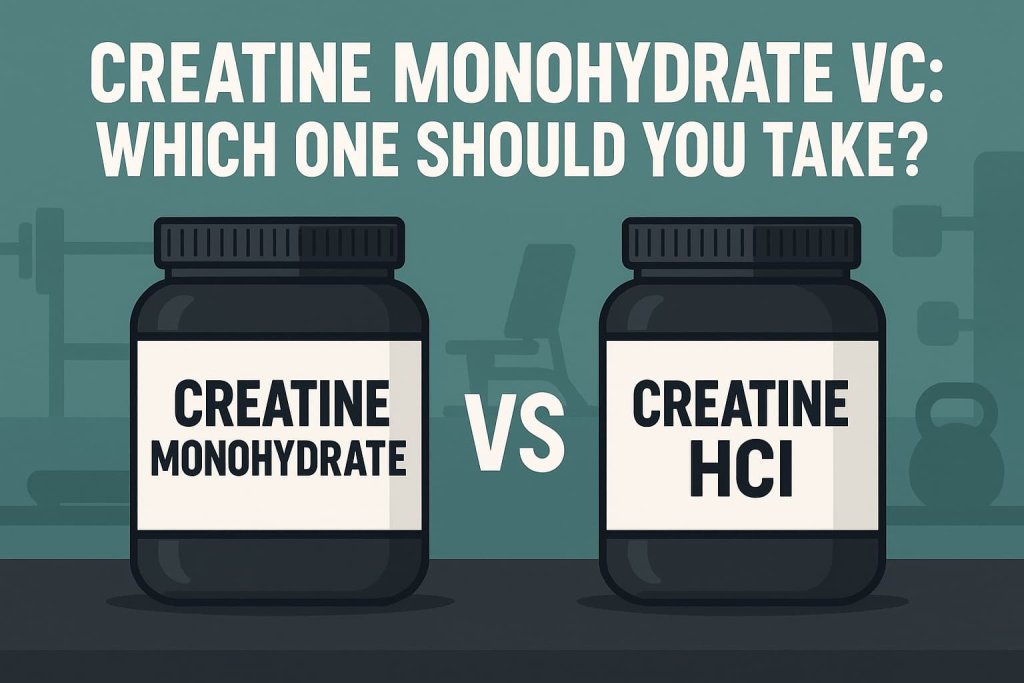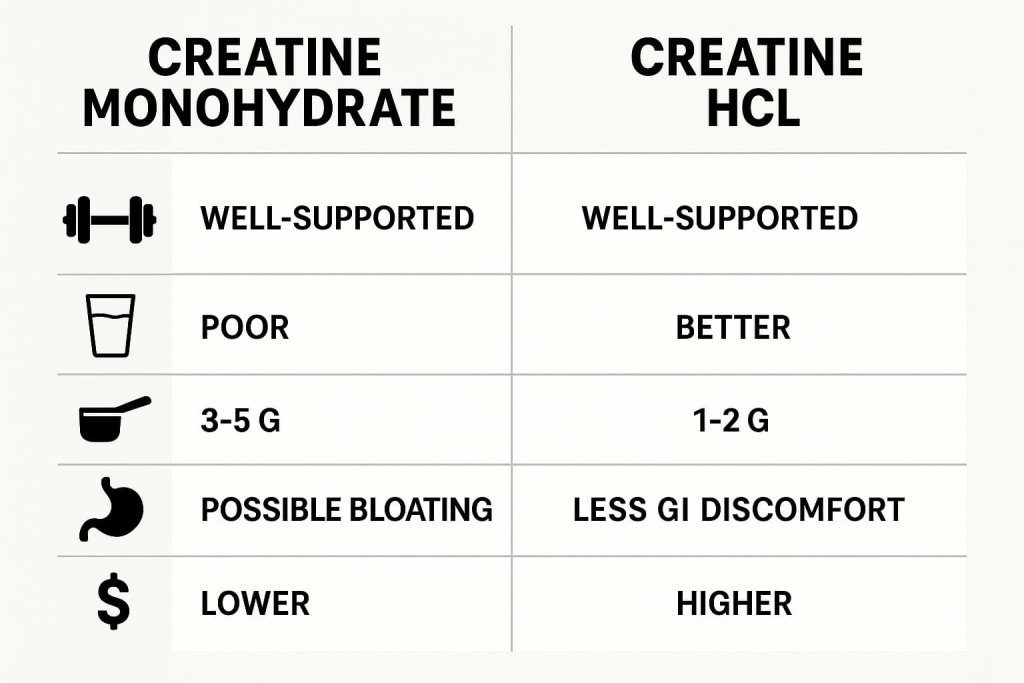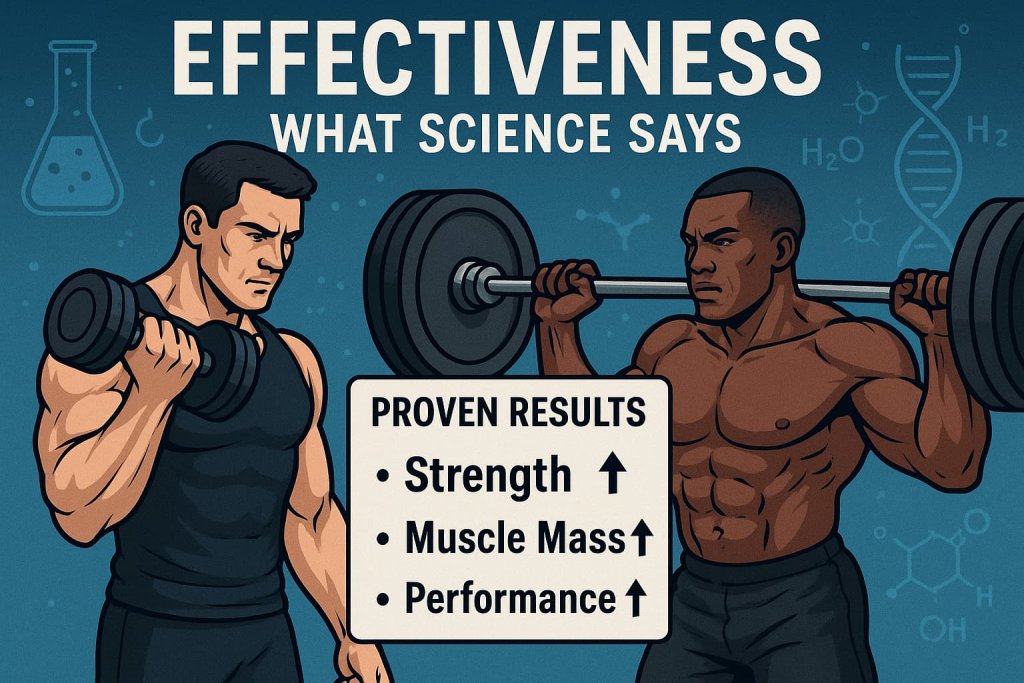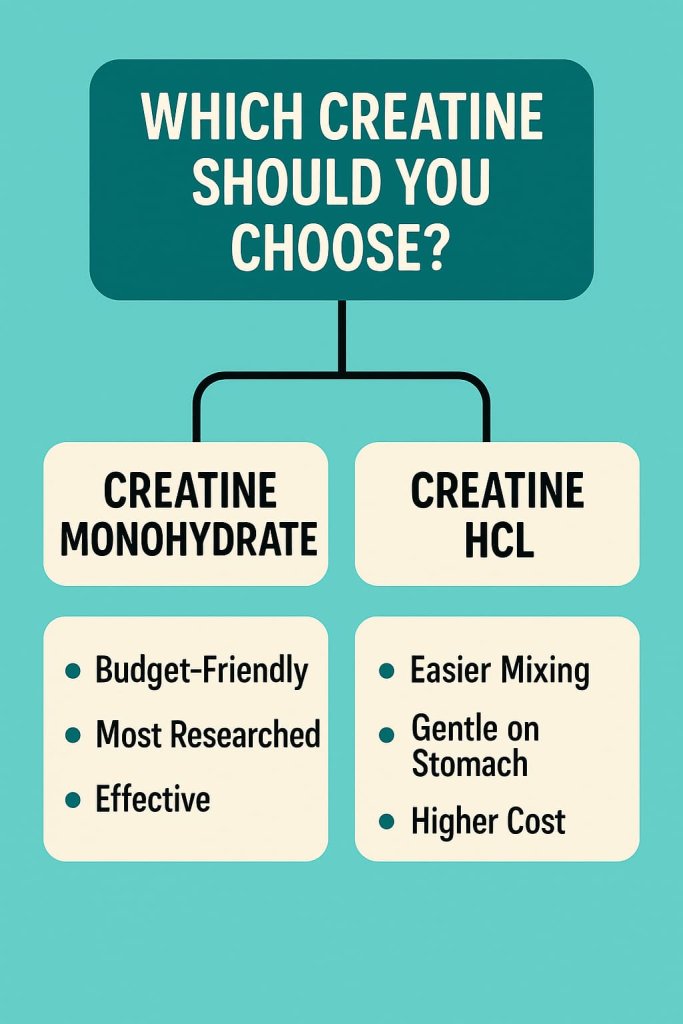Creatine monohydrate is still the gold standard, while creatine HCl offers a more soluble alternative for those with stomach sensitivity.
If you’re deciding between creatine monohydrate vs creatine HCl, you’re not alone. Creatine is one of the most researched sports supplements, shown to boost strength, muscle growth, and exercise performance. In this guide, we compare the two head-to-head—effectiveness, solubility, dosage, side effects, and cost—using the latest 2024–2025 research so you can pick the right fit for your goals and budget.

What Is Creatine Monohydrate?
Creatine monohydrate (CrM) is the most widely studied form of creatine. Research over decades links CrM with improvements in strength, power, lean mass, recovery, and high-intensity performance. It’s creatine bound to one water molecule (“mono-hydrate”). While it’s less soluble than some newer forms, it remains the benchmark for results and safety (Mayo Clinic).
What Is Creatine HCl?
Creatine hydrochloride (Cr-HCl) binds creatine to hydrochloride, which improves water solubility and often mixes easier. Many brands market HCl as needing smaller doses with fewer stomach issues. Early research suggests it is effective, but—so far—not superior to monohydrate for muscle or strength outcomes (PubMed, 2024 RCT).
Creatine Monohydrate vs HCl: Head-to-Head Comparison

| Factor | Creatine Monohydrate | Creatine HCl | Verdict |
|---|---|---|---|
| Effectiveness | Decades of studies show reliable strength & muscle gains | Fewer studies but also effective; no clear advantage vs CrM | Both work; CrM has the stronger evidence base |
| Solubility | Lower; may leave residue if not mixed well | Very high; mixes easily | HCl wins on solubility |
| Dosage | 3–5 g/day (optional loading: 20 g/day for 5–7 days) | Often marketed as effective at 1.5–2 g/day; evidence limited | Follow label; CrM’s 3–5 g/day is a reliable standard |
| Side Effects | Possible water retention or mild GI upset (esp. with loading) | Marketed as gentler on stomach; clinical data limited | HCl may suit sensitive stomachs |
| Cost | Very affordable | Typically more expensive per serving | CrM wins for budget/value |
| Research Backing | Hundreds of studies across populations | Handful of trials to date | CrM remains the gold standard |
Effectiveness: What Science Says

Both creatine monohydrate and creatine HCl improve strength, muscle growth, and high-intensity performance, but current evidence does not show HCl outperforming monohydrate.
Creatine increases intramuscular phosphocreatine, which supports faster ATP regeneration during short, intense efforts. The result is higher power output, more total reps, and better set-to-set recovery.
Evidence on Creatine Monohydrate
- Most studied form: Hundreds of trials link monohydrate to gains in 1RM strength, lean mass, and repeated sprint performance. An overview from Examine.com summarizes the large evidence base and long-term safety in healthy adults.
- Practical dosing: Consistent benefits with 3–5 g/day alongside resistance training.
Evidence on Creatine HCl
- Fewer published trials: An 8-week study found both HCl and monohydrate increased leg press strength with minimal differences between groups (de França et al., 2015).
- Recent RCT (2024): Resistance-trained adults taking HCl or monohydrate improved strength, lean mass, and reduced fat versus placebo; HCl did not significantly outperform monohydrate (Eghbali et al., 2024).
Solubility vs Results
HCl dissolves more easily and may feel gentler on the stomach, but higher solubility does not automatically mean superior absorption or outcomes. To date, trials do not show HCl producing greater strength or hypertrophy than monohydrate.
Bottom Line on Effectiveness
- Creatine monohydrate: Gold standard—robust evidence, reliable results, and best value.
- Creatine HCl: Effective alternative for those prioritizing mixability or GI comfort, without clear performance superiority.
Dosage Guidelines
The right creatine dosage depends on the form you choose, but most evidence supports consistent daily use rather than complicated cycling.
Creatine Monohydrate Dosage
- Loading Phase (Optional):
- Take 20 grams per day, divided into 4 doses of 5 g each, for 5–7 days.
- This quickly saturates muscles with creatine.
- Maintenance Phase:
- After loading, continue with 3–5 g per day.
- This maintains elevated muscle creatine levels.
- No-Load Approach:
- Skip the loading phase and simply take 3–5 g daily.
- Full saturation takes ~3–4 weeks, but results are the same long term.
According to the Mayo Clinic, doses up to 5 g per day are considered safe for healthy adults when used consistently.
Creatine HCl Dosage
- Typical Serving:
- Many brands recommend 1.5–2 g per day, citing improved solubility and absorption.
- Research Evidence:
- A 2015 study tested both 1.5 g/day and 5 g/day of creatine HCl and found increases in strength and muscle mass in both groups Food and Nutrition Sciences.
- No Loading Phase Needed:
- Most manufacturers market HCl as not requiring a loading phase.
- Caution:
- While smaller doses may be effective, there is no universal consensus that 1.5 g always equals 5 g of monohydrate. More independent research is needed.
Practical Tips for Best Results
- Take creatine at the same time daily—consistency is more important than timing.
- Mix with water or a carbohydrate-rich drink to aid absorption.
- Stay well-hydrated, as creatine increases water storage in muscle cells.
- Pair with resistance training for maximum benefit.
👉 Bottom line:
- Creatine monohydrate: 3–5 g/day (with optional 5–7 day loading phase).
- Creatine HCl: 1.5–2 g/day is commonly marketed, but evidence is still limited—following the label is best.
Side Effects & Safety
Creatine is considered safe for healthy adults when used at recommended intakes. Common effects include transient water retention (scale weight may rise) and, occasionally, mild digestive discomfort—more likely with large single doses or during loading. People with kidney disease or relevant medical conditions should consult a healthcare professional first (Mayo Clinic; NCBI review on kidney function).
HCl’s higher solubility may help users who experience GI upset with monohydrate, though formal evidence for fewer side effects is limited.
Cost & Value
- Creatine Monohydrate: Lowest cost per effective dose; widely available and often third-party tested.
- Creatine HCl: Typically 2–3× more expensive per gram; pays off mainly if you value solubility or have stomach sensitivity.
Who Should Choose Which?

Both creatine monohydrate and creatine HCl are effective, but the best choice depends on your priorities, goals, and personal experience.
Choose Creatine Monohydrate if you:
- ✅ Want the most researched option — Monohydrate has decades of studies proving its effectiveness for strength, muscle growth, recovery, and performance.
- ✅ Prefer a budget-friendly supplement — It’s the cheapest form available and widely sold, often third-party tested for purity.
- ✅ Don’t mind mixing a bit longer — It may take extra shaking to dissolve fully, but results remain the same.
- ✅ Can tolerate mild water retention — Some users experience a small increase in scale weight due to water being pulled into muscle cells, which is normal and can actually help performance.
- ✅ Are new to creatine — Beginners benefit most from monohydrate because it’s reliable and simple, without confusing dosing claims.
Choose Creatine HCl if you:
- ✅ Experience bloating or stomach discomfort — HCl’s higher solubility can reduce GI issues some people report with monohydrate.
- ✅ Prefer a smaller scoop size — HCl is often marketed at lower doses (1.5–2 g/day) thanks to its solubility, which some find more convenient.
- ✅ Value quick mixing and no residue — HCl dissolves easily in water and leaves little to no sediment in your shaker.
- ✅ Don’t mind paying more — HCl is typically two to three times the cost of monohydrate. If comfort and convenience matter most, the price may be worth it.
- ✅ Already tried monohydrate without success — If you’ve had consistent issues (digestive discomfort, water retention you dislike, or difficulty sticking with it), HCl offers an alternative.
👉 Bottom line:
- For most lifters, athletes, and budget-conscious buyers, creatine monohydrate is the best choice.
- For those with sensitive stomachs, or who want a smoother, faster-mixing option, creatine HCl is a good alternative—but not a superior one in terms of results.
Related:
FAQs: Creatine Monohydrate vs HCl
Is creatine HCl more effective than monohydrate?
No. Current studies show both forms enhance strength and muscle size, with monohydrate supported by far more evidence.
Do I need to load creatine HCl?
Most brands say loading isn’t necessary. Loading is optional for both forms; it simply saturates muscles faster.
Does creatine cause bloating?
Monohydrate can cause mild water retention. Some users report fewer GI complaints with HCl, but clinical comparisons are limited.
Which is safer long term?
Both appear safe for healthy adults when taken as directed. Those with kidney disease or other medical issues should consult a clinician.
Will creatine help if I’m not a bodybuilder?
Yes. Creatine supports strength, power, and high-intensity performance for recreational lifters, athletes, and even older adults.
What’s the best daily dose?
A practical, well-supported intake is 3–5 g/day for monohydrate. For HCl, follow product directions; evidence for very low doses is still emerging.
Conclusion: The Real Winner
For most people, creatine monohydrate wins: it’s affordable, well-researched, and reliably effective. If you struggle with GI comfort or want ultra-easy mixing, creatine HCl is a solid alternative—but not a performance game-changer. Pair either form with consistent training and adequate protein for the best results.
